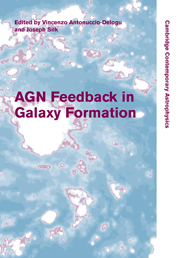Book contents
- Frontmatter
- Contents
- List of contributors
- Preface
- The organising committees
- Part I AGNs, starbursts and galaxy evolution
- Part II Co-evolution of black holes and galaxies
- Part III Outflows and radio galaxies
- 8 Interaction and gas outflows in radio-loud AGN: disruptive and constructive effects of radio jets
- 9 Young radio sources: evolution and broad-band emission
- 10 The duty cycle of radio galaxies and AGN feedback
- 11 Environment or outflows? New insight into the origin of narrow associated QSO absorbers
- Part IV Models and numerical simulations: methods and results
- Index
10 - The duty cycle of radio galaxies and AGN feedback
from Part III - Outflows and radio galaxies
Published online by Cambridge University Press: 10 November 2010
- Frontmatter
- Contents
- List of contributors
- Preface
- The organising committees
- Part I AGNs, starbursts and galaxy evolution
- Part II Co-evolution of black holes and galaxies
- Part III Outflows and radio galaxies
- 8 Interaction and gas outflows in radio-loud AGN: disruptive and constructive effects of radio jets
- 9 Young radio sources: evolution and broad-band emission
- 10 The duty cycle of radio galaxies and AGN feedback
- 11 Environment or outflows? New insight into the origin of narrow associated QSO absorbers
- Part IV Models and numerical simulations: methods and results
- Index
Summary
Introduction
In recent years, remarkably tight correlations have been observed between the properties of supermassive black holes (SMBHs) residing in galaxy cores and those of the host galaxies themselves (Magorrian et al. 1998; Gebhhardt et al. 2000; Häring and Rix 2004). A growing body of evidence seems to support the idea that feedback from active galactic nuclei (AGN) provides a natural link between these. While every galaxy can potentially host a SMBH, only a relatively small fraction of these are observed in an active state. AGN activity manifests itself through powerful outflows observable right across the electromagnetic spectrum.
The central black holes are powered by accretion of surrounding cold gas. The resultant outflows, in turn, affect the cold gas supply by heating and/or transporting this gas away from dense inner regions with short cooling times. It is for this reason that feedback from radio sources is particularly interesting. Despite only contributing around one per cent of the AGN bolometric luminosity, radio-loud AGNs can profoundly affect their surroundings through such mechanical feedback. One piece of observational evidence supporting this view comes from studies of X-ray clusters. In the absence of feedback, large amounts of cold gas are expected in dense cluster cores (due to short cooling times), however no such gas has been found. This well-known ‘cooling flow problem’ points to the need for a central, powerful heating source.
- Type
- Chapter
- Information
- AGN Feedback in Galaxy Formation , pp. 82 - 97Publisher: Cambridge University PressPrint publication year: 2010

